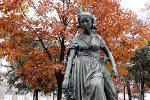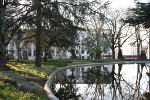U.Porto Memory
Rectory Building of the U.Porto - Framework: South side
Jardim de João Chagas (Jardim da Cordoaria)
The Jardim de João Chagas, better known as Jardim da Cordoaria, is a public garden from the second half of the 19th century (1865) designed by the German Emile David (1839-1873) who, in 1864, directed the landscaping works for Palácio de Cristal. In Porto, the name of this landscape architect is also associated with the Horto das Virtudes [Garden of Virtues] for the assistance given to José Marques Loureiro in planning other works in symbolic gardens, such as the gardens of S. Lázaro and Passeio Alegre, and to the development of a business establishment in Rua de Santa Catarina.
 Between 1999 and 2000, under the urban programme "Porto 2001 - European Capital of Culture", the Garden was totally renovated by landscape architects João Nunes and Carlos Ribas, and by architects Camilo Cortesão and Mercês Vieira. The recent rehabilitation of the garden was sponsored by the City Council of Porto.
Between 1999 and 2000, under the urban programme "Porto 2001 - European Capital of Culture", the Garden was totally renovated by landscape architects João Nunes and Carlos Ribas, and by architects Camilo Cortesão and Mercês Vieira. The recent rehabilitation of the garden was sponsored by the City Council of Porto.
The triangular-shaped garden has no fences around it, and boasts straight paths, a pond and a cast iron gazebo or bandstand on a granite foundation, as well as many diferente style sculptures from different periods: "A Flora", by master António Teixeira Lopes (1866-1942), dedicated to the florist and gardener Marques Loureiro (1830-1898), the bust of the poet António Nobre (1867-1900), by Tomás Costa (1861-1932), the sculpture of the writer Ramalho Ortigão (1836-1915), by Leopoldo de Almeida (1898-1975), "Treze a rir uns dos outros", by the Madrid artist Juan Munõz (1953-2001), and "O Rapto de Ganímedes" by António Fernandes de Sá (1874-1959).

Although it is commonly known as Jardim da Cordoaria, its real name is João Chagas (1863-1925), in honour of the writer, journalist, politician and critic of the monarchy. It replaced the Alameda da Cordoaria, the oldest green area in town, ordered by D. Filipe II (1578-1621).
A Árvore da Forca
In the former Campo do Olival, an area that today covers Campo dos Mártires da Pátria, Largo do Carmo, Largo do Moinho de Vento, Praça de Carlos Alberto and Praça de Guilherme Gomes Fernandes, and the Rua das Virtudes and Rua das Oliveiras, there was a famous elm tree that the people dubbed "Árvore da Forca" [Hangman’s Tree]. Planted during the reign of Filipe II, in the 17th century, when the olive grove lane was built, or possibly after the Motim dos Taberneiros [Innkeepers’ Mutiny], it weathered well until the 1980s despite many setbacks.
It survived the felling of trees in Cordoaria during the Siege of Porto (1832-1833), to produce fire-wood for the Military Hospital and for the School of Orphaned Children, quite possibly because of the help given by the provider of the Misericórdia, Dr. Francisco Faustino da Costa. It withstood two storms, the first on 2 February 1865, during which one of the branches broke off, and the second storm on 10 November 1963, robbing it of its main branch and giving it the unfair and sinister name by which it is known. Finally, it was spared by a councillor, the Viscount of Villar de Allen, when the grove was converted into a 19th century romantic garden.
Despite popular tradition, this mythical Ulmus campestris was never used in a hanging. It was not used to hang those involved in the Innkeepers’ Mutiny or the Company’s Mutiny (they were hanged in wooden gallows erected for that purpose in Campo do Olival), nor the 12 liberals killed in 1829.
Last updated: 2012-05-18 Webpage created on: 2025-06-16 09:34:18 Complaint Portal